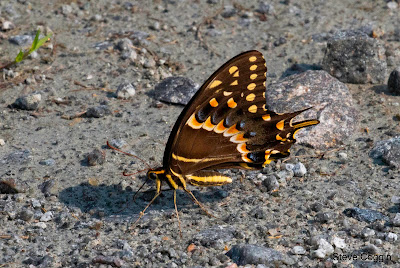 |
| A yellow female Tiger Swallowtail Butterfly (Papilio glaucus). Rowan County, North Carolina. |
Swallowtail butterflies are large, brightly-colored insects that are found on all continents except Antarctica. North America hosts about thirty species of swallowtails and eight or so live in the southeast. These butterflies get their name from the tails on their hindwings that are reminiscent of the forked tails of Barn Swallows (Hirundo rustica). The tails, along with eye-like spots on the hindwings, give the appearance of a head at the back of the butterfly. A predator zeroing in on this false head might get a bite of wing as the butterfly escapes. A number of these attention-grabbing butterflies closely resemble each other. They make up a mimicry complex where non-toxic species have evolved to look like a poisonous one.
 |
| A male Tiger Swallowtail. This butterfly has worn wings and has lost most of its tails. Rowan County, North Carolina. |
Eastern Tiger Swallowtails (Papilio glaucus) are the largest butterflies in our area. They range from the Canadian border to the edge of the Great Plains and to the Atlantic and Gulf Coasts. Eastern Tiger Swallowtails are yellow with black stripes on the forewing that give them the tiger name. The rear edges of the wings are bordered in black and have yellow spots. Male Eastern Tiger Swallowtails are always yellow but females can either have the same pattern as the males or they can be black with yellow marginal spots. The hindwings of females also bear orange and blue eye spots near the swallow tails.
 |
| A black female Tiger Swallowtail. Rowan County, North Carolina. |
Black female Eastern Tiger Swallowtails mimic their toxic relative, the Pipevine Swallowtail (Battus philenor), a butterfly that lives in the same area. The black form of Eastern Tiger Swallowtail is more frequent in the southern part of the range where Pipevine Swallowtails are more common. Many plants play host to Eastern Tiger Swallowtails including Tulip Poplar (Lireodendron tuliperia) and other members of the Magnolia family. Eastern Tiger Swallowtail butterflies can often be seen flying around the canopy of these large trees.
 |
| Pipevine Swallowtail (Battus philenor). This toxic butterfly is the model for several mimic species. Davidson County, North Carolina. |
Pipevine Swallowtails have a similar range as the Eastern Tiger Swallowtail but is more common in the southern tier of states. They are black with iridescent blue on their hindwings. Pipevine Swallowtails lay their eggs on Pipevine plants (Aristolochia sp). The caterpillars eat the leaves and store the distasteful, carcinogenic and poisonous aristolochic acid made by Pipevine. When the caterpillars metamorphose into butterflies, they retain the toxin and are protected from their avian predators. Other species of butterflies besides the Eastern Tiger Swallowtail also resemble Pipevine Swallowtail.
 |
| Underside view of a Pipevine Swallowtail. Davidson County, North Carolina. |
Black Swallowtails (Papilio polyxenes) have black wings with yellow spots. Male Black Swallowtails have large yellow spots and on the hindwings. Just in front of the tails, they have red and blue spots. Females have the same pattern but with smaller yellow spots. Like female Eastern Tiger Swallowtails, Black Swallowtails are protected by their mimicry of Pipevine Swallowtails. Black Swallowtails lay their eggs on plants in the Apiaceae, the carrot family. Larvae can be found happily eating Queen Anne’s Lace (Daucus carota), Flat Parsley (Petroselinum crispum) and other plants in this family.
 |
| Female Black Swallowtail (Papilio polyxenes). Colleton County, South Carolina. |
Spicebush Swallowtails (Papilio
troilus) are also part of the mimicry group and have a similar pattern to
Pipevine Swallowtails. Spicebush
Swallowtails get their name because they lay their eggs on Spicebush (Lindera benzoin), a shrubby tree of
swamps and rich woods.
 |
| Spicebush Swallowtail (Papilio troilus). Davidson County, North Carolina. |
Palamedes Swallowtails (Papilio palamedes) are found on the Coastal Plain of the southeast and are particularly common in swamps. These large, dark brown butterflies when seen from above have yellow bands and spots on the wings. The underwings of Palamedes Swallowtails have yellow, orange and blue markings and a characteristic yellow strip on the body. Many butterflies, including swallowtails, drink mineral laden water from moist soil. This behavior is called puddling. We found a large mixed group of swallowtails puddling at the Alligator River National Wildlife Refuge in Dare County, North Carolina.
 |
| Palamedes Swallowtail (Papilio palamedes) puddling. Alligator River National Wildlife Refuge, North Carolina. |
 |
| Two Palamedes and an Eastern Tiger Swallowtail. Alligator River National Wildlife Refuge, North Carolina. |
A striking swallowtail that is not in the Pipevine Swallowtail mimicry complex is the beautiful Zebra Swallowtail (Protographium marcellus). Zebra Swallowtails are found in most of the eastern United States. The host plant for Zebra Swallowtails is Pawpaw (Asiminia triloba). Pawpaws produce a neurotoxin and the Zebra Swallowtail is one of the few species that is resistant to the toxin. The caterpillars and adults of Zebra Swallowtails are protected as a result of eating Pawpaw. Zebra Swallowtails have triangular wings with black and white stripes that suggest their namesake mammal. Zebra Swallowtails have long tails and bright red eyespots on the hindwings.
 |
| Zebra Tiger Swallowtail (Protographium marcellus). Rowan County, North Carolina. |
Many cultures associate butterflies with change and
transformation. In Christianity the
metamorphosis from chrysalis to flying creature represents resurrection. The flight of the Swallowtails is a welcome sight
in our woods and fields.
No comments:
Post a Comment